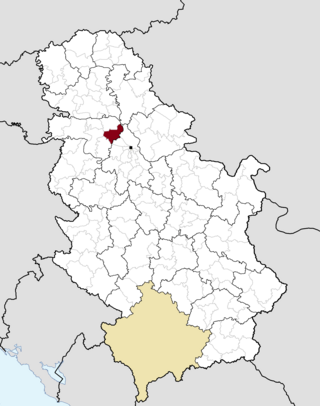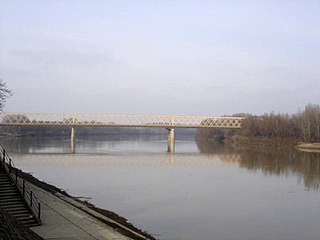
Mihajlo Idvorski Pupin, also known as Michael Pupin, was a Serbian-American electrical engineer, physicist and inventor.

The South Banat District is one of seven administrative districts of the autonomous province of Vojvodina, Serbia. The administrative center of the district is the city of Pančevo. The district lies in the region of Banat. According to the 2022 census results, it has a population of 260,244 inhabitants.

Kovačica is a town and municipality located in the South Banat District of the autonomous province of Vojvodina, Serbia. According to the 2022 census, the town has a population of 5,398, while the municipality has 21,178 inhabitants. It is widely known for its naïve art that the local residents make without any form of art school.
Vojvodina's demographic history reflects its rich history and its former location at the border of the Ottoman and Habsburg empires and at the confluence of various peoples, making it a hotbed of invasion, colonization, and assimilation processes. Currently there are more than 25 ethnic groups living in Vojvodina and six official languages.

Alibunar is a town and municipality located in the South Banat District of the autonomous province of Vojvodina, Serbia. Alibunar town and Alibunar municipality have a population of 2,883 and 19,780 respectively.

Opovo is a town and municipality located in the South Banat District of the autonomous province of Vojvodina, Serbia. The town has a population of 4,546, while Opovo municipality has 10,475 inhabitants.

Beočin is a town and municipality located in the South Bačka District of the autonomous province of Vojvodina, Serbia. The population of the town is 7,839, whilst Beočin's municipality population is 15,726. There is also a Beočin Monastery from the 16th century in the municipality.

Stara Pazova is a village located in the Srem District of the autonomous province of Vojvodina, Serbia. The town has a population of 18,042, while Stara Pazova municipality has 65,792 inhabitants. The entrance into town from Inđija lies on 45th parallel north, it is half-way between the North pole and the equator.

Potisje is the name of the Tisa river basin parts located in Serbia, in the autonomous province of Vojvodina. The river Tisa flows between the Banat and Bačka regions.

The Serbs of Vojvodina are the largest ethnic group in this northern province of Serbia. For centuries, Vojvodina was ruled by several European powers, but Vojvodina Serbs never assimilated into cultures of those countries. Thus, they have consistently been a recognized indigenous ethnic minority with its own culture, language and religion. According to the 2022 census, there were 1,190,785 Serbs in Vojvodina or 68.43% of the population of the province.

Jaša Tomić is a town located in the municipality of Sečanj, in the Central Banat District of Serbia. It is situated in the Autonomous Province of Vojvodina. The town has a Serb ethnic majority and a population numbering 2,982 people.

Dubovac is a village in Serbia. It is situated in the Kovin municipality, in the South Banat District, Vojvodina province. The village has a Serb ethnic majority (84.02%) and its population numbering 1,283 people.

Debeljača is a village in Serbia. It is situated in the Kovačica municipality, in the South Banat District, Vojvodina province.

Deliblato is a village in Serbia, situated in the Kovin municipality in the Vojvodina province. The village has a total population of 3,498, with a Serb ethnic majority and a Romanian minority. The Deliblatska Peščara, the largest sandy area in Europe, was named after this village.

Crepaja is a village in Serbia. It is situated in the Kovačica municipality, in the South Banat District, Vojvodina province, about 18km north from Pančevo. The village has a Serb ethnic majority (88.15%) and its population numbering 3,866 people.

Putnikovo is a village in Serbia. It is situated in the Kovačica municipality, in the South Banat District, Vojvodina province. The village has a Serb ethnic majority (97.53%) and its population numbering 243 people.

Samoš is a village in Serbia. It is situated in the Kovačica municipality, in the South Banat District, Vojvodina province. The village has a Serb ethnic majority (89.73%) and its population numbering 1,247 people.

Donji Petrovci is a village in Serbia. It is situated in Ruma municipality, Srem District, Vojvodina province. The village has a Serb ethnic majority and a population of 991 people. There is a significant ancient Roman archaeological site near the village - the remains of large city Bassianae, which in the 3rd century had the highest status of colonia.

Memorial Complex in Idvor is dedicated to the life and work of Mihajlo Pupin. It is located in Pupin's native village Idvor in Vojvodina (Serbia). The Memorial Complex in Idvor consists of Mihajlo Pupin's home, the Old School, the elementary school which he attended and the National Home which is Pupin's foundation. Memorial Complex in Idvor is protected as a monument of culture of exceptional Importance.























